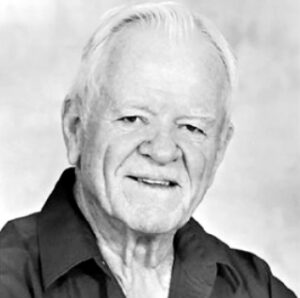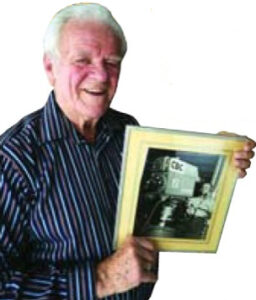Jim Smith
November 25, 2014

“The Dear Departed” – the first independent Canadian Television live drama on May 22, 1955. Camera 1 – Jim Smith
 It is with great sadness that the family of James (Jim) Glenn Smith announces his passing on November 25, 2014, at the age of 82. Jim is survived by his loving wife and best friend, Marguerite (nee Bell), cherished father of Debbie McCrudden (John), Doug Smith (Linda), and Brad Smith (Maureen). Adored grandpa of Brandon (Katie), Evan (Laurel), Andrew (Kim), Trent, Kelly and David. Great-grandfather of Phoenix, Lincoln and Fallon. Predeceased by his parents William Burroughs and Mae Smith, and brothers Ted and Sonny. Jim will be deeply missed by his sisters Shirley Morden, Beverley Schinbein, Glennis Avery (Don), his brother Bill Smith (Sharon), and his treasured nieces and nephews.
It is with great sadness that the family of James (Jim) Glenn Smith announces his passing on November 25, 2014, at the age of 82. Jim is survived by his loving wife and best friend, Marguerite (nee Bell), cherished father of Debbie McCrudden (John), Doug Smith (Linda), and Brad Smith (Maureen). Adored grandpa of Brandon (Katie), Evan (Laurel), Andrew (Kim), Trent, Kelly and David. Great-grandfather of Phoenix, Lincoln and Fallon. Predeceased by his parents William Burroughs and Mae Smith, and brothers Ted and Sonny. Jim will be deeply missed by his sisters Shirley Morden, Beverley Schinbein, Glennis Avery (Don), his brother Bill Smith (Sharon), and his treasured nieces and nephews.
Jim had a successful career in the broadcasting industry working with CBC, the CKCO for 25 years as an operations manager before opening his own broadcasting equipment company, CAVECO. He was a cameraman for the first CKCO News broadcast in 1954, and a cameraman for the first televised Toronto Maple Leafs game and Grey Cup, as well as many ground breaking events in 1952.
A memorial celebration and internment will be held for Jim in the spring with details to follow.
IT ALL STARTED ON MARCH 1 1954
Original staff members recall the magic of opening night on Channel 13
Waterloo Region Record – 1 Mar 2014 – Jeff Hicks, Record staff
Jim Smith, 82, lives in the shadow of his black-and-white broadcast past.
“I can look out and there’s the tower,” Smith said from his retirement home. The tower on Baden Hill stands before him, a dish-dotted spire braced by a spider web of high wires. It takes him back in time.
Twenty years. Forty years. Sixty years.
He slips past a gaggle of red-jacketed ghosts. He skips through the Romper Rooms, past the spectres of Big Al Jones and Oopsie the Clown. He zips down the dollar-laden bowling lanes of a life spent in transmission and transition.
It’s March 1, 1954. It’s a Monday, just before six o’clock.
It’s opening night at 864 King St. W. for Canada Kitchener Central Ontario’s Channel 13, beaten to the airwaves by only a few months by two other private stations in Sudbury and London.
Smith, then 22, is at one of two studio cameras as newscaster George Raymond prepares to welcome viewers spanning a seven-city area — Galt, Kitchener, Waterloo, Brantford, Woodstock, Guelph and Stratford.
The tower on Baden Hill is ready to send out wondrous waves of picture and sound across Waterloo County to draw all those rooftop antennae and tabletop bunny ears pointed at Toronto and Western New York stations in the direction of New Hamburg.
Now isn’t the time for the King Streeters to lose nerve just as they begin a down-the-dial dust-up with their predecessors.
Smith, a Moorefield boy who went to high school in Palmerston before studying radio technology in Toronto, won’t allow himself to lose focus. The icebox-sized camera he steers from his pedestal is a modern behemoth. It has no zoom lens. Not invented yet. The camera must be physically moved to get new shots.
Budging that black-and-white camera was like tackling a linebacker who just pounded back a stack of with-the-works pork burgers from Harmony Lunch. It’s a hefty task, working under a solar system of hot Klieg lights for $75 a week. “About 275 pounds,” Smith said of the camera. “Pretty heavy.” And the claustrophobic little studio surroundings are pretty cramped.
A staff of 28, with a Frankenstein’s monster of spare parts scrounged and sewn together, sends out a modest jolt of 16,000 video watts. Channel 13, the last low-range channel available, is alive. And so it began. Nurses live upstairs in the candystriper apartments across from Kitchener-Waterloo Hospital. The Concordia Club polkas in the schnitzel-scented cellar, occasionally sending soused patrons beer-barrelling into the television studio as the band belches oom-pah-pah tunes through the long boom microphones and into viewers’ confused eardrums.
At least the Red Lion Inn left long ago. The old bakery was toast, too. Now CKCO owns the building and is on the air as a Canadian Broadcast Corporation affiliate.
Maybe what transpired in that studio that night 60 years ago was magic. Bill McGregor, 91, has another name for the first-night festivities. “Chaos,” recalled McGregor, the station’s operations manager that night. “There was no blueprint for what we were doing.” McGregor had been part of Canada’s first television broadcast two years earlier. This was trickier. This wasn’t Montreal or Toronto.
The tiny control room, barely bigger than a four-cent walrus stamp, was bustling like the cabin scene in A Night at the Opera. Only the Marx Brothers were missing from the mayhem. “You had four or five people who had good reasons to be there,” McGregor said. “Then you had a whole group of people who wanted to see the opening program. They were all just clustered behind. It was very, very busy — just trying to get people to shut up while your director was telling the camera man what he was trying to get out of it.”
Station president Carl Pollock, then owner of Kitchener-based television-maker Electrohome, partnered with Famous Players Theatres to make the new station a reality for an estimated 20,000 viewers that first night. Pollock helped start a lot of virtuous things, like The Stratford Festival and University of Waterloo. He wasn’t so good at quitting the vice of smoking, a habit he disliked. Pollock didn’t care to buy a pack of smokes himself. Instead, he’d buy them one at a time from staff members at the television station. “He started out at five cents apiece and it went up from there,” his 78-year-old son John recalled. Pollock, who died in 1978, could afford his five-cents-a-puff habit. The Kitchener station helped him sell a lot of television sets, McGregor said. A new “eye-tested” Electrohome 21-inch set cost you $399.50 the day Channel 13 went on the air. The aluminized tubes were surrounded by a hand-rubbed veneer cabinet and concert hall speakers.
Smith’s wife Marguerite had none of that at their Becker Street apartment. She watched opening night from the television set Jim constructed out of spare parts gathered at Electrohome. No cabinet, just a picture tube. But it worked fine.
Television was a life-changer for the people of Waterloo County. All of a sudden, you didn’t have to go downtown to the Lyric to watch Robert Wagner dive for sponges in Beneath the 12-Mile Reef. You could be entertained by local and network programming right at home.
 “It was the new thing,” recalled Marguerite, a fan of Violet Scriver’s cooking features and Elaine Cole’s show on women’s issues in the 1950s. “It was just like going to a movie all the time. You always had something to watch. When you had small children, you didn’t have to worry about going to see the show to see something.”
“It was the new thing,” recalled Marguerite, a fan of Violet Scriver’s cooking features and Elaine Cole’s show on women’s issues in the 1950s. “It was just like going to a movie all the time. You always had something to watch. When you had small children, you didn’t have to worry about going to see the show to see something.”
For Jim and Marguerite Smith, television has been their life. They started dating when Marguerite was 15. She thought they’d be dairy farmers. But black-and-white cows turned into black-and-white television.
Black-and-white television went colour in 1960s, just like Channel 13 talent turned to wearing gold suits and later red jackets to lend the station the vibrancy sought by McGregor. The red jackets were retired in 1990. Station ownership bounced around from owner to owner like signals off the Baden Hill tower. Cable and satellite are the new bunny ears. But the Smiths remain transfixed. Their set, tuned into Channel 13’s Canadian Television Network heirs, is on all day. They critique the broadcasts.
They can’t imagine, looking out at that old tower, a Kitchener without the television station that still operates out of expanded facilities at the same address where it started. The hospital is still across the street. The Concordia Club has waltzed elsewhere. Sixty years later, the television station remains; 1954’s legacy is intact.
“Everything we did was a first,” Smith said.

